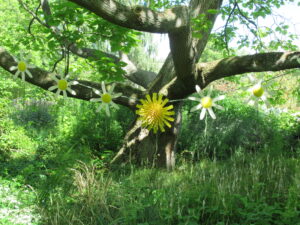Statement.
Initially Linda worked in wood, fibre glass, metals, ceramics, stone, plaster, and found objects, exploring all these materials and methods of making with a deep fascination for process. Many of these early works were forms influenced by the ‘laws of chance’, her local natural environment, or the human form. She was influenced at this time by the work of Jean Arp and David Smith. Since then Linda has developed two lines of work, although they do sometimes overlap.

One line of work references the form, mass, structure, and sense of balance to be found within her local rocky landscapes, and the penetrating and intertwining nature of different organic materials within those landscapes. Rather like looking at clouds in the sky and identifying images we know, these rocky structures will themselves suggest forms and ideas which are stored in the subconscious. This work is then created by freely assembling separate, manipulated forms until they represent a ‘whole’ object which resonates with that inner psychological store of memories and ideas. The form may then be carved into or drawn on with prehistoric spirals, lines, and cup and ring markings.
In recent years Linda has also combined these works with organic materials and found objects to visually extend and emotionally strengthen the image she has created. These materials may include animal bones and teeth, human hair, seeds, feathers, dragonfly wings, shells, and eggshells. (The animal bones and wings have been taken from the remains of creatures already found deceased in the local environment). She may also use found objects such as rusted metal parts which have been discovered in the landscape, and write words or sentences on the work which support her ideas. (Cover image: ‘She sells sea shells’, and Watchtower)

The other line of work is created in response to a location, historical building, or theme, and is often site specific. For example ‘Chain Gang’ which was created for a Yorkshire Sculptors Group exhibition at Harlow Carr, derived from what Linda felt was a common childhood memory of laying on the grass and twining flowers together into a daisy chain. This idea mixed with the sense of a ‘chain gang’ which reflected how some people perceive these little flowers negatively in their lawns, prompted her to use metal chain and hang on to it the flowers which were made from water based fibreglass, polystyrene, lollipop sticks, and paint. The flowers, like many of her sculptural ‘objects’, are hugely enlarged from life, and the chain hung from tree to tree. A new and unexpected dimension to this work was created when it became part of the venue’s light show.

The piece called ‘Puppet’ was created for an exhibition commemorating the role Scarborough had during the First World War when the town was bombarded from the sea. Here there is the idea of how little control people have over themselves and their own lives in times of war and how the population is used by the enemy to try to create an atmosphere of fear and submission. The child is in separate, broken, pieces and held together by wire. He/she is tagged with a brown Identification label on one foot and the head is torn open with the names of the people who died in the bombardment pasted inside the head. Personal reflections of the devastating impact of war have combined together to create this three dimensional form.
Both avenues of work have intertwined and overlapped for many years and Linda’s work is still growing and changing, her use of materials still expanding, and she is still discovering different ways in which to express her aesthetic ideas and experiences in our challenging and changing world.